
Henry has contracted with growers to do a handful of local crop pollinations this year (blueberries for Radke’s Blueberries and Gibson Farms plus raspberries, blackberries, and strawberries for Sunset Valley Organics), but the one crop pollination that he’s been most excited about is clary sage. Clary sage is known for its medicinal properties and for its usefulness in cosmetics, and the purple or white blooms can be seen in fields around the Willamette Valley.
Mike Hathaway is a young grass seed and filbert farmer in Corvallis, Oregon (more about Mike in this article in the local newspaper), and he’s growing a small field of clary sage for the first time this year. Henry knows Mike from their college days when they were both studying agriculture. They’ve crossed paths a few times over the years and have chatted about beekeeping, so when Mike needed bees for pollination for the first time (grass seed and filberts are both wind pollinated), he gave Henry a call.
Henry moved several pallets of bees to the edge of the field around Memorial Day just as the sage started to bloom. The photos in this post were taken on June 22 when the bloom was on the decline. In the month prior, the bees worked the clary sage pretty hard, but they also probably brought in nectar and pollen from nearby hairy vetch and blackberries.
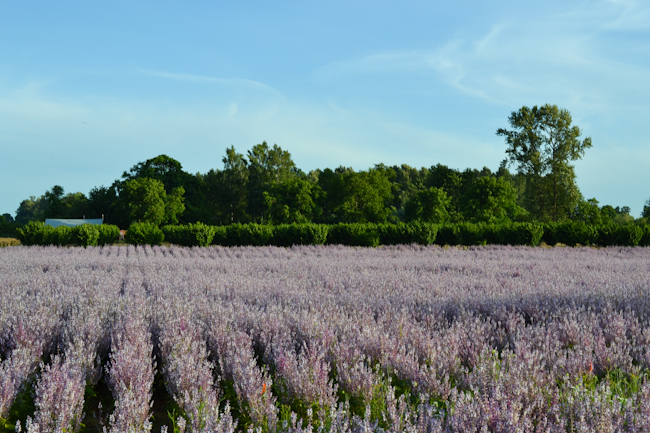
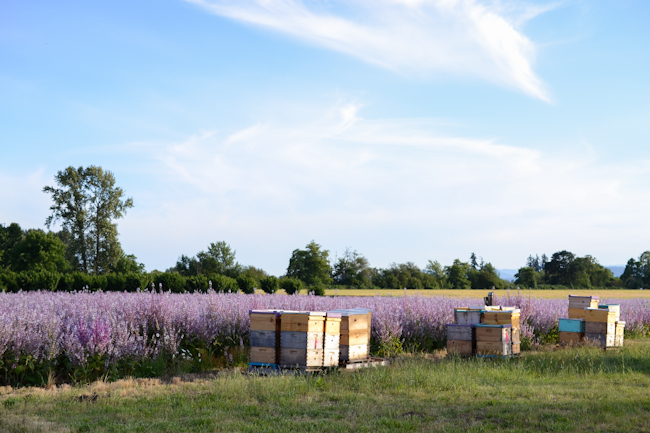

As the clary sage bloom died down, Henry wanted to pull frames of honey in order to keep this varietal batch separate from the later season valley nectar flows. Unlike the frames containing our earlier varietals, these frames of honey were mostly capped already, and because he knew the end result would only be four or five buckets of honey, he decided to extract on-site.
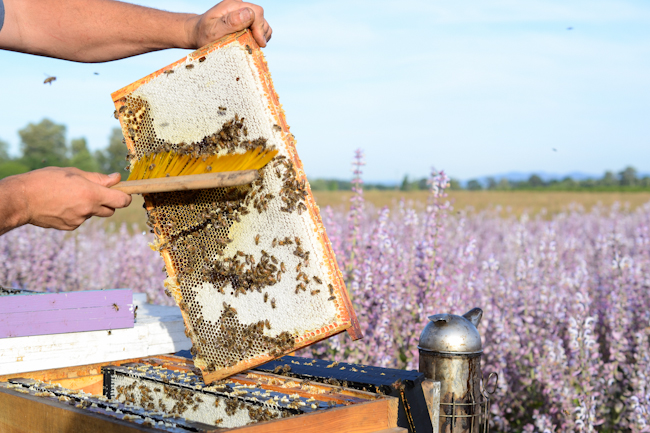
Full frames of honey are too heavy to shake to remove the bees, so Henry used a special beekeeping brush to sweep them off the frames he wanted to extract.


Mike the grower, came out to help and stayed the whole time. He was very curious to learn more about both honeybee pollination and honey extraction. Mike and his wife are big honey fans, and he actually traded 100 pounds of filberts in-shell with us for honey last fall. We’re still working our way through the filberts, but Mike and his wife had eaten all their honey and were ready for more.


Henry pulled any frames from the top box of each hive that had capped honey.

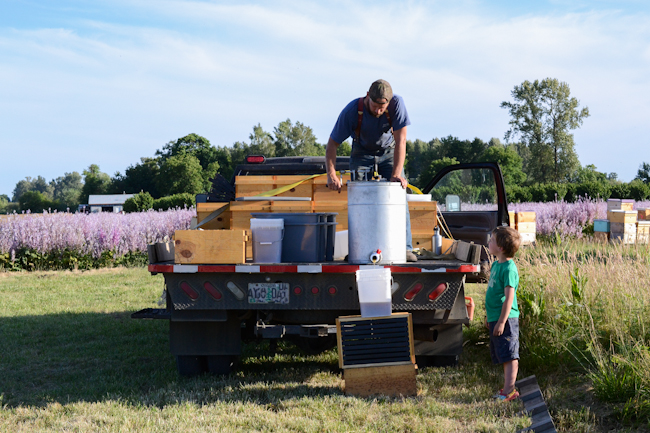
We have a four-frame, hand-crank extractor that can be set up on the back of Henry’s flatbed truck. It’s not ideal, but it’s pretty efficient for small-batch extractions, and we had a hand washing station there as well to keep things as clean as possible. With farm-direct laws in Oregon, honey sold direct to consumers does not necessarily need to be extracted in a licensed facility. We do, however, hold ourselves to a high standard of sanitation when working on this messy task.
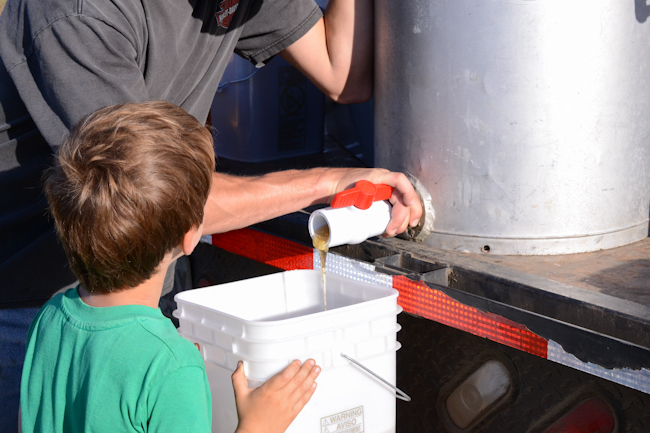

Extracting on-site works pretty well when there’s still a lot of nectar resources available for bees. We hardly noticed the few bees buzzing around the truck. Later in the season when food is scarce, bees will actively rob any honey they can find and are significantly more aggressive. An operation like this would be a honeybee mob scene in another month.
One of the biggest benefits of extracting on-site is that the wets (empty or nearly empty frames of extracted comb) can go immediately back into the hives to be refilled with incoming nectar. Because he’s been focusing on increasing his number of hives for the past couple years, Henry doesn’t have a surplus of frames of drawn comb. Swapping full frames of honey out for frames with only foundation can slow honey production because the bees have to draw comb before they can fill it.

We also got a little help from the kids.

The resulting honey (unfiltered in the photo above) is light in color and bright in flavor. We STILL haven’t bottled any for sale yet, but we’ll be getting there soon.
Mike is planning on growing a much larger field of clary sage next summer, so hopefully, Henry and his bees will be back out here a year from now.
Clary Sage Pollination and Honey Extraction
Henry has contracted with growers to do a handful of local crop pollinations this year (blueberries for Radke’s Blueberries and Gibson Farms plus raspberries, blackberries, and strawberries for Sunset Valley Organics), but the one crop pollination that he’s been most excited about is clary sage. Clary sage is known for its medicinal properties and for its usefulness in cosmetics, and the purple or white blooms can be seen in fields around the Willamette Valley.
Mike Hathaway is a young grass seed and filbert farmer in Corvallis, Oregon (more about Mike in this article in the local newspaper), and he’s growing a small field of clary sage for the first time this year. Henry knows Mike from their college days when they were both studying agriculture. They’ve crossed paths a few times over the years and have chatted about beekeeping, so when Mike needed bees for pollination for the first time (grass seed and filberts are both wind pollinated), he gave Henry a call.
Henry moved several pallets of bees to the edge of the field around Memorial Day just as the sage started to bloom. The photos in this post were taken on June 22 when the bloom was on the decline. In the month prior, the bees worked the clary sage pretty hard, but they also probably brought in nectar and pollen from nearby hairy vetch and blackberries.
As the clary sage bloom died down, Henry wanted to pull frames of honey in order to keep this varietal batch separate from the later season valley nectar flows. Unlike the frames containing our earlier varietals, these frames of honey were mostly capped already, and because he knew the end result would only be four or five buckets of honey, he decided to extract on-site.

Full frames of honey are too heavy to shake to remove the bees, so Henry used a special beekeeping brush to sweep them off the frames he wanted to extract.
Mike the grower, came out to help and stayed the whole time. He was very curious to learn more about both honeybee pollination and honey extraction. Mike and his wife are big honey fans, and he actually traded 100 pounds of filberts in-shell with us for honey last fall. We’re still working our way through the filberts, but Mike and his wife had eaten all their honey and were ready for more.
Henry pulled any frames from the top box of each hive that had capped honey.
We have a four-frame, hand-crank extractor that can be set up on the back of Henry’s flatbed truck. It’s not ideal, but it’s pretty efficient for small-batch extractions, and we had a hand washing station there as well to keep things as clean as possible. With farm-direct laws in Oregon, honey sold direct to consumers does not necessarily need to be extracted in a licensed facility. We do, however, hold ourselves to a high standard of sanitation when working on this messy task.
Extracting on-site works pretty well when there’s still a lot of nectar resources available for bees. We hardly noticed the few bees buzzing around the truck. Later in the season when food is scarce, bees will actively rob any honey they can find and are significantly more aggressive. An operation like this would be a honeybee mob scene in another month.
One of the biggest benefits of extracting on-site is that the wets (empty or nearly empty frames of extracted comb) can go immediately back into the hives to be refilled with incoming nectar. Because he’s been focusing on increasing his number of hives for the past couple years, Henry doesn’t have a surplus of frames of drawn comb. Swapping full frames of honey out for frames with only foundation can slow honey production because the bees have to draw comb before they can fill it.
We also got a little help from the kids.
The resulting honey (unfiltered in the photo above) is light in color and bright in flavor. We STILL haven’t bottled any for sale yet, but we’ll be getting there soon.
Mike is planning on growing a much larger field of clary sage next summer, so hopefully, Henry and his bees will be back out here a year from now.